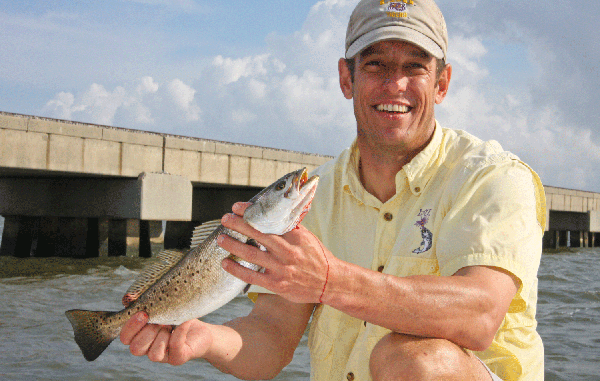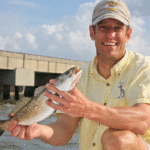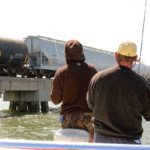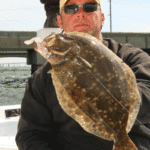
Everybody knows the trestles are hot in April. Fewer anglers know that the party actually gets started on warm days in March.
The best way to have a fishing hole all to yourself is to fish it when nobody else is there. If that makes me sound like Captain Obvious, so be it. Sometimes the best advice is the simplest advice.
But when John Kendrick invited me to fish the train trestle on the east side of Lake Pontchartrain during March, I ha d to wonder if he was just a little bit too devoted in his desire to have a fishing hole all to himself. Because I had never given much thought to fishing the trestle before April or May, Kendrick assured me that we weren’t getting too much of a head start.
Following a frigid few weeks of brutally cold weather, two weeks with afternoon highs in the upper 70s had given the speckled trout a major case of spring fever.
Kendrick limited out for three straight trips before he thought about inviting me to tag along just to make sure the bite was solid enough to put together a fourth full box of trout.
I met up with Kendrick and his frequent fishing parter, Capt. Travis Miller with Miller Time Fishing Charters (985-981-6434), at Dockside Bait & Tackle just south of Eden Isles. Unfortunately, the weather had soured on us behind a cold front the night before, so I was thankful we didn’t have a long run to get to the trestle.
We planned to try out a few of the new Matrix Shad soft plastics that, at the time, Chas Champagne was hand pouring one at a time, but we also had a few bags of lemon drop and avocado glow Hybrid Flurry minnows. In Kendrick’s estimation, we wouldn’t need anything else.
“The trout were in the deep holes back in Lakeshore and Geoghegan Canal at the end of January, but then we hit about a three-week lull. It just went dead,” Kendrick said as he started casting toward the pilings below the trestle. “It started picking up about a week ago with this warm weather.”
Undeterred by the suddenly cold temperature and neap tide, Kendrick just barely swam his avocado soft plastic inches above the bottom on the west side of the trestle.
Miller, on the other hand, was almost violently jerking his lemon drop plastic hard off the bottom and letting it flutter straight back down. It was immediately apparent which retrieve was best as Kendrick began hauling in trout, redfish and flounder.
I asked Kendrick to explain why he was fishing so slowly and on the bottom while Miller, who primarily guides out of Bayou DuLarge, was popping his so hard off the bottom.
“We’ve got a combination of three things that I believe have the fish lethargic on the bottom,” Kendrick started. “Neap tide combined with hardly any water movement and that cold front last night is making them act a little goofy.”
In these kinds of conditions, Kendrick would normally work from one extreme to the other to see if he had to crawl them out or if he could aggravate them enough to bite with an aggressive retrieve.
Rather than having to figure it out on his own, Kendrick tried the slow retrieve on bottom while Miller tried more of hard pop off the bottom. When it was obvious that slower was better, Miller slowed his retrieve down and started picking up just as many fish as Kendrick.
“I actually go through about 10 different jigging patterns throughout the day to see what the trout want,” Kendrick explained. “And I use jigging as a general term because all these different ways of fishing it range from a swimming retrieve to a true jigging and popping action.”
Kendrick begins his experimentation in tough conditions with a slow swim with his rod held low so his bait works just over the bottom. After trying a swim-and-pause retrieve if the straight swim doesn’t work, he raises his rod up and tries the same two swimming retrieves higher in the water.
“I try a few different depths with the swimming retrieve, then switch to the pop,” Kendrick went on. “I’ll jig it a while with my rod parallel to the water and work my way up to where my rod tip is sticking straight up. What I’m trying to do is mix and match to try to find the magic combination.”
When he finds the right retrieve, Kendrick sticks with it for as long as the fish let him know that they like it that way. If the bite slows down, he generally gives the retrieve about an hour before going through the process all over again.
“As a rule of thumb, a certain retrieve will generally hold for about that long,” Kendrick said. “Within an hour, something usually changes to affect the bite. Whether it’s the wind or tide changing. Or maybe it gets cloudy or warmer.”
After catching up with Kendrick’s fish count, Miller just couldn’t help himself and started aggressively popping his lemon drop Hybrid hard off the bottom and letting it fall straight back down. Within an hour, Miller proved that the bite was changing.
“I like to fish more aggressively, but I couldn’t let John whack me like that,” Miller quipped. “That’s why I slowed down and just lifted my bait off bottom and placed it back down rather than popping it and letting it fall. It’s been an hour, and it’s getting warmer. I think the trout are waking up. We’ll see how long it’ll hold up.”
We spent all day on the west side of the train trestle. Kendrick and Miller agreed that the west side seems to hold a far greater number of trout than the east side. They will take time to check the east side if conditions are favorable to fish that side, but there are too many things that converge during the early spring to make the west side better.
According to Kendrick, the long shoreline coming from New Orleans East forces a lot of current to sweep down that shoreline, and for some reason, that forces a lot of trout to get hung up on the west side.
“With the spring migration, an incoming tide and a southeast wind, the west side of the trestle is just a natural spot for the fish to hold,” Miller said. “Trout like to get behind something and have ambush points. That’s what we find on the west side. The pilings break the current and trap bait in the swirls.”
Kendrick explained that he has found that the stronger the tide, the farther away from the bridge trout hold. And conversely, on a lighter tide or when the tide starts getting ready to change and slow down, trout move up tighter to the pilings.
The pilings don’t totally break the current as much as they create swirling eddy pockets on the downcurrent or downwind side. It is in that swirling current break where Kendrick usually picks up his fish.
“You can feel that edge with your bait,” Kendrick said. “If you cast up to the pilings, you’ll notice the current pulling hard on your bait. Then it gets maybe 10 or 15 yards off the bridge, and you feel that pull start lightening up. Trout aren’t going to expend the energy to fight the current all day, so they sit back in that little bit calmer water and wait on bait.”
After three straight limits the week before, our numbers went way down with three adults and one kid aboard Miller’s bay boat. But taking into consideration that all the odds seemed to be stacked against us with the cold front and neap tide, we considered our 31 trout, 12 flounder and five redfish to be a nice box of fish.
Bearing in mind that December and January of 2010 and 2011 were a lot colder than this past December and January, Kendrick says he expects the bite on the trestle to start even earlier this year than last.
“We came out of some bitter cold with just two weeks of warm weather and the bite took off last year,” he pointed out just a few weeks ago. “Looking back, I think a major factor of the early bite was that the lack of shrimping due to the BP deal kept a lot of shrimp in the lake. A little warm weather, and it was on.”
This year, Kendrick believes there are just as many good signs pointing to another early bite on the train trestle, the most significant of which was that the water temperature in late January was 66 degrees. That’s about a 20-degree difference from the consistent 40 degrees from last year.
“It’s highly unusual for the water to be that warm in January,” Kendrick said. “I think it’s going to bring them out of the deep holes and into the shallow water a lot earlier.
“As long as the weather holds warm and we don’t get any long cold snaps, they’re going to stay in that shallow water. And that means they’re going to be on the west side of the train trestle a lot earlier than most people would expect them to be.”
But if our mild winter gives way to an even milder spring, don’t expect to have the whole bridge to yourself.





